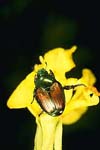 Description: 3/8-1/2" (8-12 mm). Oval, sturdy. Body bright metallic green; elytra mostly brownish or reddish orange. Grayish hair on underside and 5 patches of white hair along each side of abdomen with 2 white tufts at tip. Male has pointed tibial spurs; female's are rounded.
Description: 3/8-1/2" (8-12 mm). Oval, sturdy. Body bright metallic green; elytra mostly brownish or reddish orange. Grayish hair on underside and 5 patches of white hair along each side of abdomen with 2 white tufts at tip. Male has pointed tibial spurs; female's are rounded.
- Food Adult damages leaf tissues and ripening fruit of more than 200 plants, including vines, flowers, shrubs, and trees. Larva feeds on roots, especially those of grasses, vegetables, and nursery plants.
- Life Cycle Elongate, yellowish-white eggs are deposited on soil, 1-4 at a time. Fully grown larvae overwinter in soil and pupate in the spring. 1 generation of adults emerges in summer when blackberries ripen. In the North, cycle takes 2 years.
- Habitat Open woods and meadows.
- Range Maine to South Carolina.
- The Japanese Beetle was introduced accidentally in 1916 on iris roots imported from Japan and has been a major pest for years. Its numbers have been reduced by the controlled use of parasitic tachnid flies and tiphiid wasps that prey on beetle larvae.